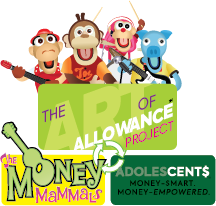The endless holiday parties are finally over, and by now you’re probably trying to shed your holiday handles, still trying to figure out how to connect your latest gadget and, of course, revisiting your allowance plan for that tween of yours. No? That’s not your number three? Well, then, maybe this post will help you reconsider.
We implemented what I’ll call “Allowance 3.0” for our 12-year-old last year, and we’ll be doing the same for our 10-year-old this year. (It’s much easier to get the younger ones rolling before the older siblings started.) After having run our Effective Allowance program at home for a few years, it was time to raise the bar and give our burgeoning teen more responsibility. She’s almost an adult already; just ask her. With saving, sharing and spending smart already part of the routine to provide financial education for our kids for more than five years, more responsibility is something our tween was certainly craving. Yours likely wants more autonomy too. Giving them “driving” lessons (with money, not cars … shudder) is a good way to go.
So here’s a very basic 3-step plan that we used, and you can too:
Real Responsibilities
She’s now responsible for clothes, gifts and food, per the advice of David McCurrough in Allowance Magic. This includes birthday gifts for friends, school lunches and bites out to eat in the neighborhood with buddies. She gets more allowance money as a part of this new deal, so she can afford these expenditures each month. Being the wonderful parents that we are, we don’t (yet) make our kids pay for family nights out on the town.
Bang Out a Bare Budget
Next, it was up to her to figure out a budget that included the amount of school lunches she’d want monthly, birthday presents she’d need annually and Brandy Melville shirts she’d buy over the course of the next year. Again, being such wonderful parents, we pay for the home-prepared lunch fixin’s, so laying off the school slop can be a big money-saver for her. By making her responsible for birthdays, she’s motivated to be more creative about gifts and to consider, for example, a personalized vs. a store-bought card. She’s even taken to creating her own t-shirts with pithy sayings that cost $45 plus at retail. I’m still waiting for my “My Dad Is the King” shirt.
Put the Plan in Place
We use FamZoo, Bill Dwight’s terrific program that makes it easy to both track money and transition from the Money Mammals jars (Share, Save and Spend Smart) to “virtual” jars. We can also use it to incentivize saving by including an interest rate on any Save account money she stockpiles. Interestingly, about two months in, she asked if she could be paid weekly, but we said no. Not because we’re mean, and it’s our way or the highway. (We’d NEVER say that … ha!) She needs to learn to make that monthly windfall last until the end of the month. You know, like when, as an adult, you have to deal with periodic paychecks. The more real-world-y you can make your program, the better. Now that I think about it, I KNEW there was a reason, aside from my devotion to our nation’s forefathers, that I love February.
So what if you haven’t been following the Effective Allowance and you have a tween that you’d like to start teaching money smarts? Well, forget it. There’s no hope. You are now raising a profligate spender, financial education for your kids is out of reach and you might as well just come to terms with that.
I kid. I kid.
Start with a basic allowance on a weekly or bi-weekly basis. Try this post about allowance and its importance in teaching financial education for kids for more detail. Or watch the Effective Allowance video via the link above. Let that run for a few months so your kids get comfortable with making smart money choices, and then you’ll likely be ready for Allowance 3.0.
Good luck!
